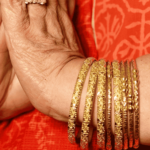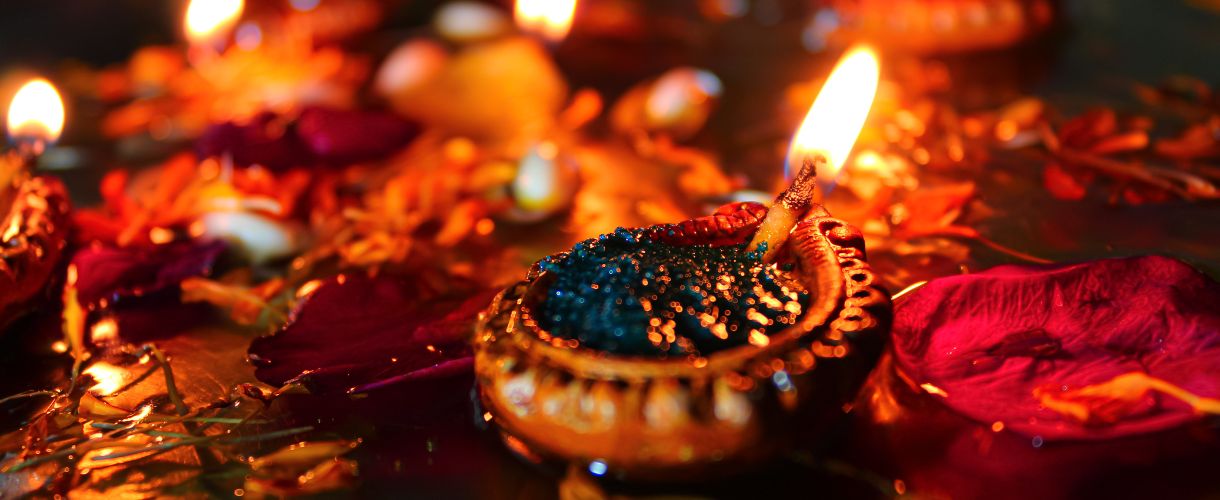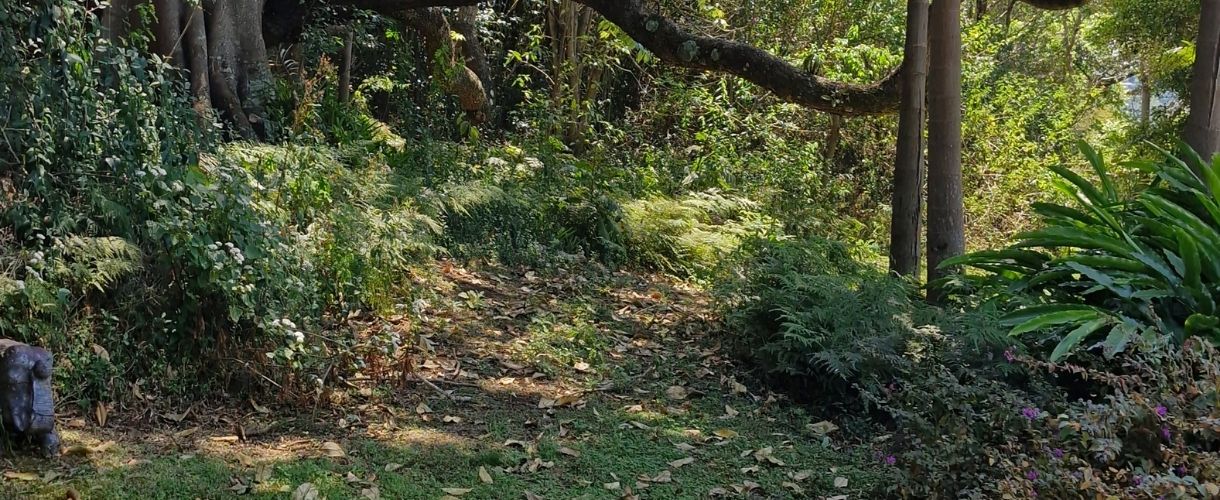
How to Implement Mouna in Your Daily Life
October 8, 2024
Namaste
November 22, 2024DIWALI: THE FESTIVAL OF LIGHTS
One of the most significant festivals that originated in the Indian subcontinent is Diwali, the Festival of Lights. It is India’s biggest and most important holiday of the year. It is celebrated across faiths in the world’s most populous nation and the diaspora.
History
The festival, most likely a fusion of harvest festivals in ancient India, is observed every year in the early autumn of the Northern Hemisphere, after the conclusion of the summer harvest. This falls on the 15th day of the Hindu month of Kartik, in the period of the second-half of October to early November, so it varies every year. It coincides with the new moon (amāvasyā) and is deemed the darkest night of the Hindu luni-solar calendar.
It is mentioned in early Sanskrit texts, such as the Padma Purana and the Skanda Purana, both of which were composed between 7th century to 10th century. The diyas (lamps) mentioned in Skanda Kishore Purana symbolise parts of the sun, which is described as the cosmic giver of light and energy to all life, and which seasonally transitions in the Hindu calendar month of Kartik. It symbolises the spiritual victory of light over darkness, good over evil, and knowledge over ignorance.
Etymology
Also known as Deepavali and Dipawali, it gets its name from the continuous row or line (avali) of lamps, lights, lanterns, candles which glow, shine, illuminate (deepa) which Indians light outside their homes to symbolise the inner light that protects from spiritual darkness.
Economics
This festival is as important to Hindus as the Christmas holiday is to Christians, and particularly associated with the goddess of prosperity, Lakshmi, as a celebration of her birthday, (Lakshmi is said to have been born on the new-moon day of Kartik) and marks the beginning of the financial year in India.
Diwali marks a major shopping period in India, and is comparable to the Christmas period in terms of consumer purchases and economic activity. It is traditionally a time when households purchase new clothing, home refurbishments, gifts, gold, jewellery, and other large purchases particularly as the festival is dedicated to Lakshmi, the goddess of wealth and prosperity, and such purchases are considered auspicious. Other goods that are bought in substantial quantities during Diwali include confectionery and fireworks. Rural Indians spend a significant portion of their annual income during this time of the year, and it is a means for them to renew their relationships and social networks.
Politics
Diwali has increasingly attracted cultural exchanges, becoming occasions for politicians and religious leaders worldwide to meet Hindu or Indian origin citizens, diplomatic staff or neighbours. Many participate in other socio-political events as a symbol of support for diversity and inclusiveness. Many governments encourage or sponsor Diwali-related festivities in their territories, and organise many cultural events during Diwali every year, using the occasion to highlight contributions of the Hindu community to society.
Every year during Diwali, Indian forces approach their Pakistani counterparts at the border bearing gifts of traditional Indian confectionery, a gesture that is returned in kind by the Pakistani soldiers who give Pakistani sweets to the Indian soldiers.
Sacred Mythology
Hindus interpret the Diwali story and its celebration based upon where they live. Mythical tales shared on Diwali vary widely depending on the region, even within Hindu tradition. But there’s one common theme no matter where people celebrate: that good ultimately triumphs over evil. They thus share a common focus on righteousness, self-inquiry and the importance of knowledge as the path to overcoming the darkness of ignorance.
The current most celebrated significance is rooted in the sacred mythology that commemorates the return of Rama (the hero of the legendary Hindu epic, Ramayana) with his wife Sita and brother Lashman, to the kingdom of Ayodhya, after 14 years in exile, having defeated the demon king Ravana’s army of evil. (In Indian mythology, Rama is one of the incarnations of Vishnu, the Preserver, one of the main identities of the Hindu trinity. Throughout the epic, Rama’s decisions were always in line with dharma duty, and the Diwali festival serves as a reminder for followers of Hinduism to maintain their dharma in day to day life). In joyous celebration of the return of their king, the people of Ayodhya, illuminated the kingdom with earthen diyas (oil lamps) and set off firecrackers.
Celebrations
During the festival, celebrants illuminate their homes, temples and workspaces with oil lamps (diyas), candles and lanterns. During Diwali, the act of lighting lamps and candles represents the dispelling of darkness (ignorance, ego, and negative thoughts), not only in our homes but also in our souls.
Rituals and preparations for Diwali begin days or weeks in advance, typically after the festival of Dussehra (a Hindu holiday marking the triumph of Rama, an avatar of Vishnu, over the 10-headed demon king Ravana, who abducted Rama’s wife, Sita) that precedes Diwali by about 20 days.
In preparation for the Diwali fervour, the annual exercise of thorough cleanliness begins at homes and business premises across the country. The act of Diwali cleaning is not merely physical, but bears profound spiritual significance, as it is a time for self-reflection and inner cleansing. This is not just any regular exercise. It symbolises a harmonious blend of inner and outer purity. Just as homes are prepared to shine brightly with the glow of lamps, people are expected to illuminate their hearts with love, eliminating old grudges, seeking forgiveness, and mending broken relationships. Another aspect of the festival is remembering one’s ancestors.
The entire festival is celebrated over five days, and includes good food, fireworks (which increase the concentration of dust and pollutants in the air), special candles and lamps. Hindus have a ritual oil bath at dawn on each day of the festival. People clean and whitewash their homes, wear new clothing and create decorative and circular art floor designs called rangoli using coloured powders or sand, and also decorate other parts of the home.
The festival is an annual homecoming and bonding period not only for families, but also for communities and associations, with organised activities, events, and gatherings. Many towns organise community parades and fairs with parades or music and dance performances in parks Food is a major focus with families partaking in feasts and sharing Indian confectionery.
The Five Days Of Diwali
The festival formally begins two days before the night of Diwali, and ends two days after. Each day has the following rituals and significance:
Day 1: Dhanteras – puja to Lakshmi, Ganesh, Dhanvantri
Day 2: Naraka Chaturdashi – puja to Hanuman, Yama deepam
Day 3: Amavasya and the Festival of Lights – puja to Lakshmi, Kali
Day 4: Govindhan Puja
Day 5: Bhai Dooj.
Day One: The Festival Of Wealth And Prosperity
Dhanteras, marks the onset of Diwali, and honours Lakshmi and Lord Dhanvantari for prosperity and health. Derived from Dhan meaning wealth and teras meaning thirteenth, it marks the thirteenth day of the dark fortnight of Ashwin or Kartik and the beginning of Diwali in most parts of India.
The day is regarded as being a harbinger of good luck, wealth, prosperity and abundance. People clean their homes, with many indulging in either token, or full-fledged shopping for silver or gold. or new utensils, home equipment and other items to help bring good fortune. This is called Dhanteras.
The term Dhan for this day also alludes to the Ayurvedic icon Dhanvantari, the father of Ayurveda, who is believed to have emerged from the churning of cosmic ocean of milk (samudra manthan) by gods (devas) and demons (asuras) on the same day as Lakshmi, the goddess of wealth and prosperity, consort of Vishnu. Some communities, particularly those active in Ayurvedic and health-related professions, celebrate the auspicious birth anniversary of Dhanvantri, and the time-honoured path of Ayurveda to health and wellbeing. Ayurveda is not merely a system of medicine, it’s a lifestyle that fosters balance and prosperity, and is a gift from India’s rich culture.
People decorate their homes by installing small, earthen oil-filled lamps called diyas, which they light up for the next five days. Women and children decorate doorways within homes and offices, creating colourful designs, called rangoli, using rice flour, flower petals, coloured rice or coloured sand, while the boys and men decorate rooves and walls of family homes, markets, and temples and string up lights and lanterns.
Day Two, The Festival Of Feasts
Chhoti Diwali, is the major shopping day for festive foods, particularly Indian sweets (mithai) which are stocked for home celebrations to welcome guests and as gifts. A variety of sweets are prepared using flour, semolina, rice, chickpea flour, dried fruit pieces, ground or paste, milk solids (mawa or khoya) and clarified butter (ghee).. These are then shaped into various forms, known as laddus, barfis, halwa, kachoris, shrikhand, and sandesh, or rolled and stuffed delicacies, such as karanji, shankarpali, maladu, susiyam, pottukadalai. Sometimes these are wrapped with edible silver foil. Families also prepare homemade delicacies. It is a day for visiting friends, business associates and relatives, and exchanging gifts.
Though rangoli is a defining feature of the festival, and in some homes on the sub-continent, it assumes special significance on Chhoti Diwali.
Also known as Naraka Chaturdashi (naraka means hell, and chaturdashi means the fourteenth day of the dark fortnight of Ashwin or Kartik), it marks the vanquishing of the demon Naraka by Lord Krishna and his wife Satyabhama. The day and its rituals are interpreted as ways to liberate any beings from their suffering in Naraka (hell) as well as a reminder of spiritual auspiciousness. It is a day to pray for the peace to the manes, or defiled souls of one’s ancestors and light their way for their journeys in the cyclic afterlife.
Day Three. The Festival Of Light
The main festival of Diwali falls on the third day, coinciding with the darkest night of the traditional month of Ashvin or Kartika.
The youngest members in the family visit their elders, such as grandparents and other senior members of the community, on this day. Small business owners give gifts or special bonus payments to their employees. Shops either do not open or close early on this day allowing employees to enjoy family time. Shopkeepers and small operations perform puja rituals in their office premises. As the evening approaches, celebrants will wear new clothes or their best outfits, teenage girls and women, in particular, wear saris and jewellery.
At dusk, families gather together for Lakshmi Puja, a prayer to Goddess Lakshmi, to welcome her into their cleaned homes and to bring prosperity and happiness for the coming year (although prayers are also offered to other deities, such as Ganesha, Saraswati, Rama, Lakshmana, Sita, Hanuman, or Kubera).
After the puja, people go outside and celebrate firework festivities by lighting up fireworks (patakhe) together, which some interpret as a way to ward off all evil spirits and the inauspicious, as well as add to the festive mood.
Then a mouth-watering family feast and mithai (sweets, desserts) is shared. Unlike some other festivals, Hindus typically do not fast during the five-day long Diwali celebrations, rather they feast and share the bounties of the season at their workplaces, community centres, temples, and homes.
Day Four, Celebrating The New Year
The day after Diwali, is the first day of the new year. It falls on the first lunar day of the bright fortnight of the month of Kartika. Friends and relatives visit with gifts and best wishes for the season. Govardhan Puja is celebrated. Devotees worship Govardhan Hill and prepare and offer a large variety of vegetarian food to Krishna as a mark of gratitude based on a mythical story that he lifted the entire hillock and kept it on his little finger to save villagers, the cowherds and farming communities in Mathura from flood-like situation caused by incessant rains unleashed by an angry Lord Indra.
The agricultural symbolism is observed on this day by many Hindus as Annakut, literally ’mountain of food’. Devotees prepare over one hundred dishes from a variety of ingredients, which is then dedicated to Krishna before being shared among the community. Hindu temples on this day prepare and present “mountains of sweets” to the faithful who have gathered for darshan (blessings)
Day Five: Celebrating The Bond Between Siblings
The last day is celebrated as Bhai Dooj celebrating the bond between brothers and sisters. Celebrating with their siblings holds immense cultural and emotional significance in India. On this auspicious day, brothers visit their married sisters, who welcome them with love and express their affection by performing aarti, praying for the longevity, well-being and prosperity of their beloved brother, applying tilak (vermilion) on their foreheads, tying a protective thread around their wrists to save them from all kinds of evil forces, and a lavish meal. In return, brothers shower their sisters with gifts and promise to protect and support them throughout their lives. They may also exchange gifts with each other and shower each other with a lot of love.
Spiritual Significance
Diwali is celebrated around the world. Originally a Hindu festival, Diwali has transcended religious lines and is celebrated by Hindus, Jains, Sikhs, and Newar Buddhists. Over the centuries, Diwali has become a national festival that’s also enjoyed by non-Hindu communities, although for each faith it marks different historical events and stories. Nonetheless the festival represents the same symbolic victory of light over darkness, knowledge over ignorance, and good over evil
If you are away from the sights and sounds of Diwali, light a diya, sit quietly, close your eyes, withdraw your senses, and concentrate on the supreme light that protects from spiritual darkness and illuminates the soul.
APPENDIX : THE BASIC HINDU CALENDAR
In the Hindu calendar, or the Panchand, a year is divided into 12 lunar months.
The moon takes time to complete one revolution around the earth, and the time it takes is called a lunar month.
The Panchang measures the time in the lunar month scheme with the names of the month revealing the path of the moon through the different constellations.
A lunar month in the Hindu calendar has two fortnights, and begins with the new moon (purnima).
The time in between the two moonrises is known as the tithis/thitis. The lunar days are called tithis.
Each month has 30 tithis, which may vary from 20 – 27 hours.
A paksha has 15 tithis, which are calculated by a 12 degree motion of the moon.
The New moon day (Amavasya) marks the new month
The solar year takes 365 days to complete, and in total, there are 12 phases in a year divided into 12 lunar months.
The Hindu calendar is based on the lunar month cycle, and is known as a lunisolar calendar. The 12 months move according to the moon and the year is 354 days long. However, every third year, 33 days (11 extra days) are added by creating one extra lunar month of 29 days.
The Hindu Months
Names of the 12 months (maah or maas) of the Indian Civil Calendar and their correlation with the Gregorian calendar:
1. Chaitra (30 or 31 Days) March-April. Begins March 22 or 21, depending on the leap year
2. Vaisakha (31 Days) April-May. Begins April 21
3. Jyaistha (31 Days) May-June. Begins May 22
4. Asadha (31 Days) June-July. Begins June 22 . Lord Yoga falls asleep during this month, therefore, on this occasion, no auspicious activities including marriage, homecoming or upanayana, take place during this month, making it an inauspicious one.
5. Shravana (31 Days) July-August. Begins July 23. month of fasting
6. Bhadra/Bhadrapada (31 Days) August-September. Begins August 23
7. Asvina (30 Days) September-October. Begins September 23
8. Kartika (30 Days) October-November. Begins October 23
9. Agrahayana/Agahana (30 Days) November-December. Begins November 22
10. Pausa/ Pausha (30 Days). December-January. Begins December 22
11. Magha (30 Days) January-February. Begins January 21
12. Phalguna (30 Days) February-March. Begins February 20
So every three years, one of these months occurs twice in the same year…it’s like having two Marches or two Julys in a year! The Hindu calendar year always has 12 or 13 months. If a month is omitted, another month is added elsewhere in the year, so the number of months never drops to 11.
Names of the seven days in the Hindu week:
1.Raviãra: Sunday (day of Sun)
2.Somavãra: Monday (day of Moon)
3.Mañgalvã: Tuesday (day of Mars)
4.Budhavãra: Wednesday (day of Mercury)
5.Guruvãra: Thursday (day of Jupiter)
6.Sukravãra: Friday (day of Venus)
7.Sanivãra: Saturday (day of Saturn)





